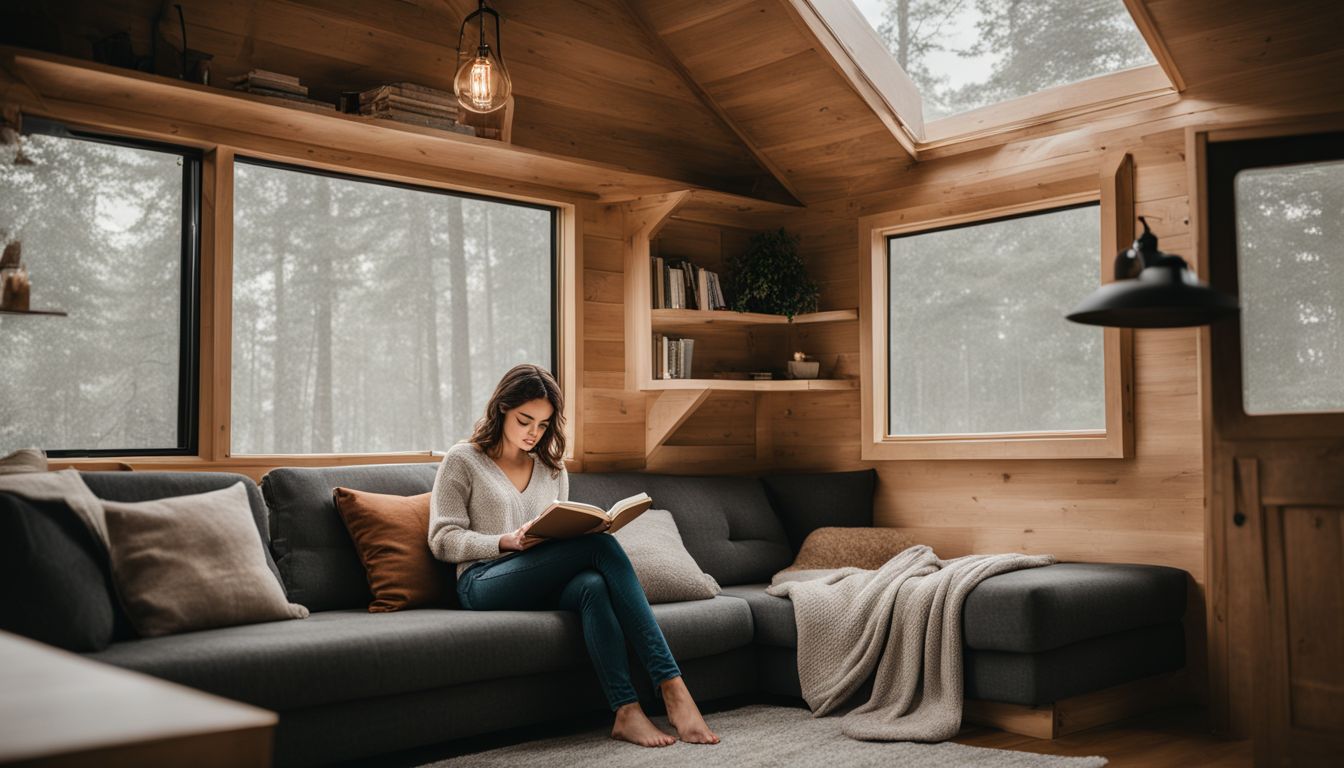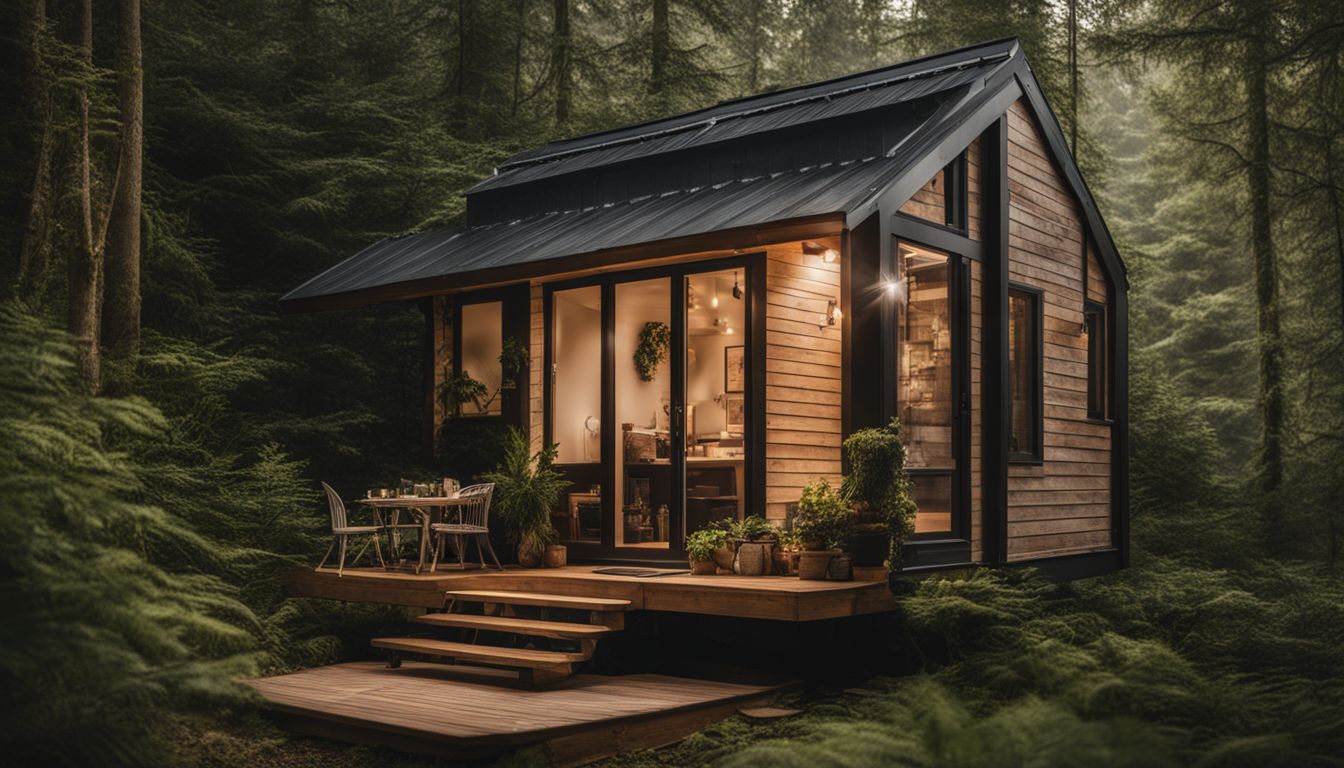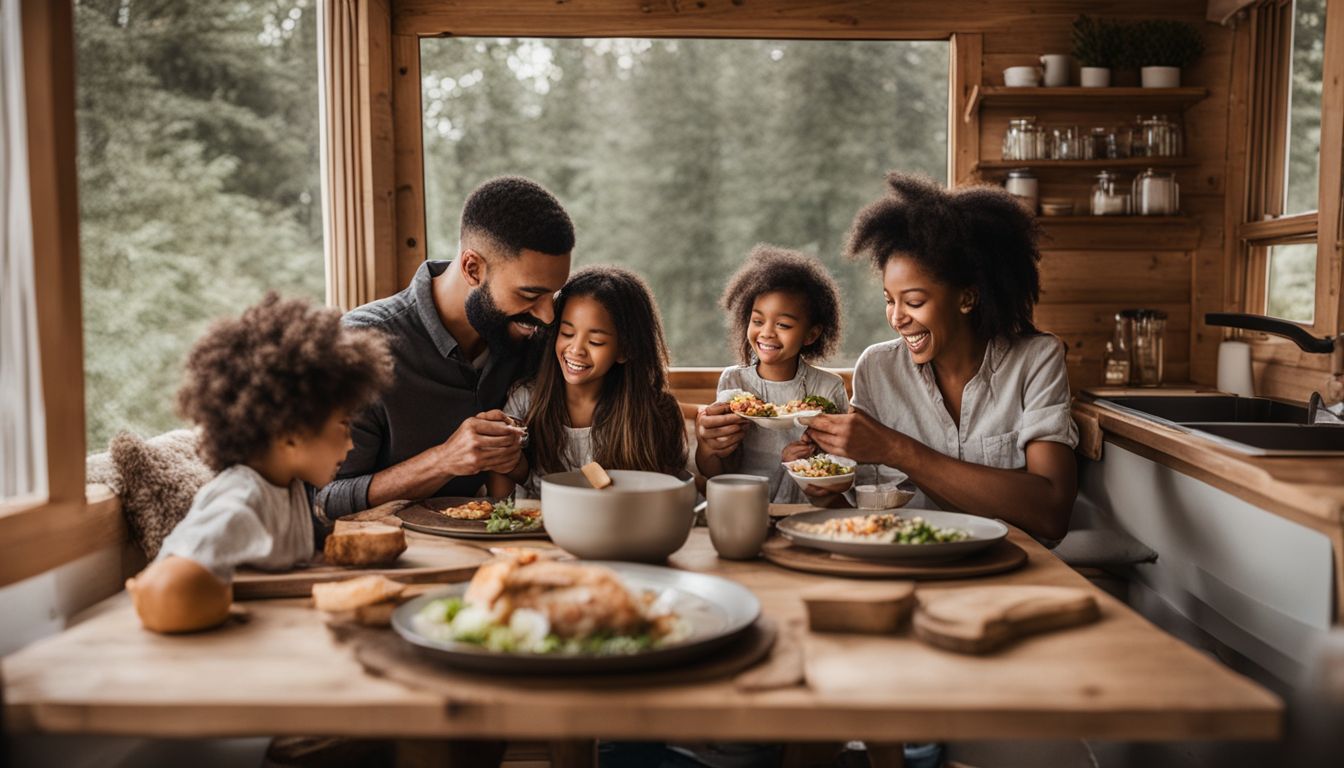
By: TinyNest Chronicles
Essential Tiny House Movement Rules to Live By: Your Ultimate Guide to Tiny House Living
Many people feel their homes are too big and costly. A key fact: the tiny house movement promotes simpler, less cluttered living. This article offers tips on joining this lifestyle, making it easier for you.
Start your journey here.
Key Takeaways
- Tiny house living focuses on simplicity, reducing clutter, and minimizing environmental impact by living in a smaller space.
- Financial benefits of tiny homes include saving money on purchases, utilities, and avoiding large mortgages, which leads to less financial stress.
- Challenges of tiny house living involve dealing with limited space, adapting to a simpler lifestyle, and navigating zoning laws.
- Starting your tiny journey involves setting a budget, designing your home strategically to use every inch wisely and spending only on essentials for minimalism.
- Options for acquiring a tiny home include building it yourself for customization, buying pre-made for convenience, hiring professionals for expertise or purchasing kits as cost-effective solutions.
Understanding the Tiny House Movement

The tiny house movement is all about living simply in a small space. This trend pushes for less clutter and more meaningful lifestyles. Living in a tiny home means you focus on what truly matters.
It’s not just about the size—it’s a commitment to reducing your environmental footprint and enhancing personal freedom.
Tiny homes come in various shapes—like miniature traditional houses or even compact mobile residences on wheels, reflecting the owner’s personality and needs. Zoning regulations often don’t favor these petite dwellings, making creativity and flexibility key.
Joining this movement reveals an appreciation for simplicity, sustainability, and a closer connection to nature.
Why People are Joining the Tiny House Movement

People are drawn to the tiny house movement for its financial benefits, simplified lifestyle, and positive environmental impact. They see it as a way to save money, declutter their lives, and reduce their ecological footprint.
Financial Benefits
Living in a tiny house saves money. You spend less on buying or building your small home compared to average-sized houses. This means you can pay off your home faster and have more money for other things.
Utility bills are also lower in a tiny home because there’s less space to heat or cool.
The size of your house doesn’t define the size of your happiness.
You avoid big mortgages that come with bigger homes. Insurance and property taxes are usually cheaper, too. By choosing tiny living, you put more cash in your pocket and stress less about finances.
Simplification
After saving money, the next step is throwing out what you don’t need. This part of tiny house living makes life easier and clearer. Owning less means less cleaning and more time for fun activities or rest.
People choose tiny homes to escape the clutter that big houses hold. Everything in a tiny home has a place and purpose.
This way of life helps folks focus on what truly matters—relationships, hobbies, and personal growth. You learn to live with essentials, making choices about what stays or goes very carefully.
Tiny house owners find joy in simplicity, proving happiness isn’t about how much you own but the quality of your lifestyle and connections.
Environmental Benefits
The tiny house movement yields substantial environmental benefits. By embracing a minimalistic lifestyle, individuals reduce their carbon footprint and energy usage significantly. Tiny homes often utilize sustainable materials and energy-efficient systems, promoting eco-friendly practices while minimizing environmental impact.
To nurture the planet and safeguard natural resources, the movement emphasizes renewable energy sources such as solar panels and rainwater harvesting systems. This commitment to sustainability fosters harmony between human habitation and the environment, contributing positively to conservation efforts.
The use of composting toilets and innovative recycling techniques further exemplifies how tiny house living champions ecological stewardship over the long term.
The Challenges of Tiny House Living
Living in a tiny house poses several unique challenges. Limited space is the most obvious hurdle, requiring residents to be highly organized and efficient in their use of space. Additionally, adapting to a simpler lifestyle and avoiding clutter can be difficult for those accustomed to more spacious living arrangements.
Furthermore, zoning laws often present obstacles for those looking to establish a permanent residence, as many areas mandate minimum size requirements that tiny houses do not meet.
Energy efficiency and off-grid living also pose technical challenges, as systems must be meticulously designed and tailored towards maximizing usage while minimizing waste.
Navigating these challenges calls for practical solutions and a shift in mindset. Embracing multifunctional furniture and clever storage solutions can help maximize space utility within tiny home interiors…
Meanwhile, exploring alternative energy sources such as solar panels or wind turbines enhances sustainability efforts… Ultimately, the willingness to adapt one’s lifestyle and adopt innovative design concepts is crucial when facing the intricate realities of tiny house living.
How to Begin Your Tiny House Journey
To start your tiny house journey, determine a budget, design strategically, and only spend on essentials. Consider building your own, purchasing a pre-made home, hiring a professional, or buying a kit for your first tiny home.
Setting a Budget
When setting a budget for your tiny house project, it’s crucial to consider potential expenses like materials, labor costs, and permits. Additionally, factoring in ongoing maintenance and utility expenses can help ensure financial preparedness.
Adhering to a strict budget will also provide greater control over the overall cost of the build. By utilizing strategic planning and cost-effective design choices, you can create a realistic budget tailored to your specific needs.
Flexibility is key when setting aside funds for unexpected expenses that may arise during construction.
…
Strategic Designing
After establishing a budget, strategic designing becomes the next crucial step in actualizing your tiny house dreams. This process involves carefully planning the layout, storage solutions, and maximizing multifunctional spaces to make the most of every square foot.
Considering concepts like minimalism and ergonomic design during this phase can greatly enhance the functionality and comfort of your tiny home.
Tools such as 3D modeling software enable you to visualize different design options before committing to a plan. Also, incorporating eco-friendly materials into your design aligns with the sustainable ethos that underpins the movement towards smaller living spaces.
Spending Only on Essentials
Transitioning from strategic designing to spending only on essentials is a crucial step in your tiny house journey. It’s about curating a living space that emphasizes simplicity and functionality.
In the realm of tiny house living, focusing on essentials means prioritizing multi-functional furniture, energy-efficient appliances, and sustainable materials. It involves embracing minimalism and consciously making choices that add value to your daily life while minimizing clutter.
This tailored approach aligns with the core tenets of the tiny house movement – promoting sustainability, reducing environmental impact, and fostering a deeper connection with one’s surroundings.
In line with the concept of spending only on essentials for your tiny home, consider incorporating space-saving solutions such as built-in storage units or convertible furniture pieces to optimize every inch of your living space.
Embrace an eco-friendly mindset by choosing durable materials that are not only cost-effective but also support sustainability initiatives within the small home movement – emphasizing the importance of self-reliance and environmental consciousness.
Acquiring Your First Tiny Home
Ready to own your first tiny home? Build it, buy a pre-made one, hire a professional, or get a tiny home kit.
Building Your Own
Building your own tiny home offers the opportunity for complete customization and personalization, tailored to fit your needs and preferences.
- Selecting the Right Design: Choose a design that maximizes space utilization according to your lifestyle needs while taking into account structural integrity and mobility features.
- Creating a Structural Plan: Develop a detailed plan encompassing the layout, materials, and construction techniques necessary to ensure a safe, durable, and aesthetically pleasing end product.
- Ensuring Compliance with Building Codes: Research local building codes and zoning regulations to ensure your tiny home meets all legal requirements for safety and habitation.
- Sourcing Quality Materials: Carefully select high-quality, sustainable materials that are both durable and suitable for the specific environmental conditions where your tiny home will be located.
- Constructing with Precision: Follow meticulous construction methods to guarantee a sturdy, well-built tiny home that will withstand the test of time.
- Incorporating Energy-Efficient Features: Integrate energy-efficient systems and appliances to reduce environmental impact and operational costs.
- Installing Essential Utility Systems: Properly install plumbing, electrical, and waste management systems in accordance with industry standards to ensure functionality and safety.
By following these steps, you can embark on an exciting journey of constructing your very own personalized tiny home that aligns with both your practical needs and aesthetic preferences!
Purchasing a Pre-made Tiny Home
Transitioning from building your own tiny home to purchasing a pre-made one offers an efficient alternative that can save time and effort. Here’s what you need to know:
- Consider Your Needs: Assess the layout and size of the pre-made tiny home to ensure it aligns with your requirements.
- Budget Exploration: Research various pre-made options to find one that fits within your financial plan.
- Quality Evaluation: Inspect the construction quality and materials used in the pre-made tiny home to ensure durability.
- Customization Opportunities: Check if there are customization options available to personalize the pre-made tiny home according to your preferences.
- Location Logistics: Confirm the transportation and site placement logistics for the pre-made tiny home before making a purchase decision.
- Legal Compliance: Ensure that the pre-made tiny home complies with zoning laws and building codes in your intended location.
- Efficient Utilities: Inquire about the electrical, plumbing, and HVAC systems provided with the pre-made tiny home for functionality.
The process of purchasing a pre-made tiny home involves meticulous consideration of factors such as budget, quality, customization, logistics, compliance, and utility efficiency to make an informed decision aligned with your needs and preferences.
Hiring a Professional
To ensure a smooth tiny house journey, hiring a professional can simplify the process. From architects to builders, seeking expert help guarantees the efficient and safe construction of your dream tiny home.
Professionals not only provide guidance on zoning laws and building codes but also offer valuable insights into sustainable design principles for an eco-friendly living space. Their expertise covers everything from maximizing storage in limited square footage to ensuring structural integrity for a durable dwelling.
Furthermore, professionals bring years of experience in creating bespoke tiny homes tailored to individual needs and preferences. With their keen eye for detail and knowledge of cost-effective materials, they aid in achieving both functionality and aesthetic appeal within your tiny abode.
Buying a Tiny Home Kit
Looking to build your own tiny home? Buying a tiny home kit is a simple and cost-effective way to start. These kits come with all the necessary materials and instructions for building your dream space.
Whether you are a seasoned builder or new to construction, these kits cater to all levels of experience. Plus, they offer flexibility in design and customization options, allowing you to create a unique living space tailored specifically to you.
With varying sizes and styles available, purchasing a tiny home kit presents an exciting opportunity for anyone ready to embark on their tiny house journey.
Investing in a tiny home kit also aligns with the self-reliant ethos of the movement as it grants owners direct involvement in constructing their living space from the ground up. Additionally, going through this process offers invaluable hands-on experience that fosters greater appreciation for every aspect of small-scale homeownership.
Therefore, buying a tiny home kit isn’t just about obtaining materials; it’s about embracing autonomy and expanding one’s skill set while actively contributing towards sustainable living practices.
Concepts: customizing homes
Adapting to the Tiny House Lifestyle
Living in a tiny house demands creativity and adaptability, but it offers unique rewards. You’ll need to adjust your mindset to embrace simplicity and minimalism. It’s crucial to maximize space by using multifunctional furniture and smart storage solutions.
Efficient organization is key; every item must earn its place. Embrace the outdoors, making nature an extension of your living space with outdoor seating areas and gardens in small yards or on rooftops.
In this lifestyle, resourcefulness is essential – learning how to repurpose items and finding joy in owning less. It’s also about community; getting involved in local events fosters a sense of belonging amongst fellow tiny house dwellers.
And finally, staying flexible will be important as you adapt to the ebb and flow of this unique lifestyle.
Concepts: Tiny House Living, Minimalistic Lifestyle, Multifunctional Furniture
Tools: Smart Storage Solutions, Efficient Organization
Conclusion
Ready to start your tiny house journey? The movement offers financial benefits and a smaller environmental footprint. You can build or purchase your tiny home, but be prepared for the challenges of downsizing.
Living in a tiny house encourages simplicity and self-reliance while aligning with nature. Are you ready to embrace the essential rules of the tiny house movement?